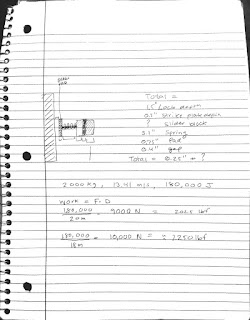Week of 10/03/2018 to 10/10/2018
I made a few changes to the emergency braking system from last week. There were several major problems that I was facing with implementing the system between the tracks. The first problem was implementing the system in such as small amount of space. The gap between the tracks is currently 12cm. This is not enough space for the whole mechanism to fit in, as I needed at least another 2 inches. I spoke to the track team to see whether we are able to extend the gap between the tracks a couple more inches. The track team wanted to keep the current dimensions of the track to 12cm because it was somehow related to the Futran system dimensions. Also several major changes needed to be implemented to extend the track a few more inches such as changing supports and widening the bogie. Ultimately, extending the track just for the e-brake system was not worth doing.
I started to experiment with several other design concepts. Dr. Furman recommended me to use a wedge braking system. The harder the wedge is forced down, it will move one rod on each side of the wedge to the edge of the track. This was a good idea, but during my calculations it was still hard to implement it in the 12cm space. During my analysis, another major problem arose which threw all my design concepts out of the window. The bogie is not fixed on the railing like a traditional train. The wheels of a train do not swing past the edges of the track because they are tapered. On the other hand, out bogie does not ride on a railing system. It uses a guide arm to guide the bogie and turn its wheels. This means that the bogie is constantly wiggling on the top of the track and if a braking system is implemented between the tracks, it will scrape the sides as the vehicle is turning.
This was a major problem and I felt like I had to start over from scratch to change the braking system. I spoke to Dr. Furman about this and after spending some time looking at the bogie, he recommended that I should implement my design from last week but change the location. So, the new design will be below the track attached next to the uni strut on the bogie. This will press up on the track from below. Currently, I am looking at performing more calculations as to decide on which parts I will use. The parts needed are springs, electromagnets, brake pads, mounting brackets, and pieces made from steel.

I started to experiment with several other design concepts. Dr. Furman recommended me to use a wedge braking system. The harder the wedge is forced down, it will move one rod on each side of the wedge to the edge of the track. This was a good idea, but during my calculations it was still hard to implement it in the 12cm space. During my analysis, another major problem arose which threw all my design concepts out of the window. The bogie is not fixed on the railing like a traditional train. The wheels of a train do not swing past the edges of the track because they are tapered. On the other hand, out bogie does not ride on a railing system. It uses a guide arm to guide the bogie and turn its wheels. This means that the bogie is constantly wiggling on the top of the track and if a braking system is implemented between the tracks, it will scrape the sides as the vehicle is turning.
This was a major problem and I felt like I had to start over from scratch to change the braking system. I spoke to Dr. Furman about this and after spending some time looking at the bogie, he recommended that I should implement my design from last week but change the location. So, the new design will be below the track attached next to the uni strut on the bogie. This will press up on the track from below. Currently, I am looking at performing more calculations as to decide on which parts I will use. The parts needed are springs, electromagnets, brake pads, mounting brackets, and pieces made from steel.




Comments
Post a Comment